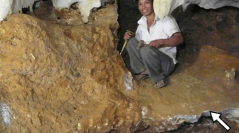

 Comptes Rendus Palevol
11 (2-3) - Pages 133-157
Comptes Rendus Palevol
11 (2-3) - Pages 133-157Karst processes typically occur in carbonate rocks, such as limestone or dolomite. They occur all over the world everywhere where carbonate rocks are exposed and submitted to rain and/or water circulation. The karstification of carbonate rocks-bearing landscapes leads to a variety of surface and subsurface features. In tropical and sub-tropical areas as it is the case in Southeast Asia, the mature karst landscapes display a typical morphology called tower karst. Beneath the surface, the complex underground drainage systems contribute to an extensive network of caves and caverns, which may be filled with breccia. The history of sedimentary cave infilling is often complicated due to alternating cycles of infilling/removing phases through time, driven by climate/tectonic/eustatic changes. We present results from our research in Vietnam and Laos. We emphasise that both modern and fossil alluvial terraces and cave entrances/exits, evolve together, and that the caves at progressively higher elevations also have older periods of formation. The oldest breccias and sedimentary deposits are on the upper part of the network, whereas the youngest ones are often close to the modern alluvial plain. These processes of formation are in many respects very similar to those of the fluvial terraces formed during the drop of the alluvial plain, showing a stair-like morphology. Additionally, the alternation of infilling and erosion is strongly linked to the progressive downcutting of the alluvial plain that leads to a major change in both, water circulation and sedimentary deposits. The bone-bearing breccias, formed by typical sedimentary processes, yield vertebrate assemblages, often essentially composed of isolated teeth from middle- to large-sized mammals (Artiodactyla, Perissodactyla, Proboscidea, Carnivora, Rodentia, Primates). In terms of zoogeography, the continental Southeast Asian mammals belong to the Indochinese Subregion. After a brief review of the evolution of the faunas throughout the Pleistocene, we present a biochronological framework of the transition between the Middle Pleistocene and the Late Pleistocene, on the basis of our research in the karsts of Vietnam (Duoi U’Oi and Ma U’Oi sites) and Laos (Tam Hang site).
Southeast Asia, Karst, Pleistocene, Mammals, Evolution